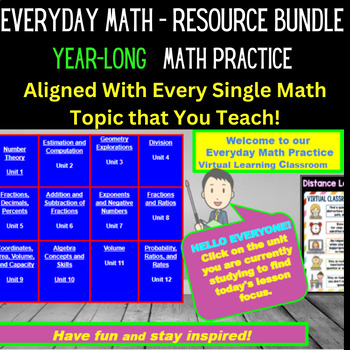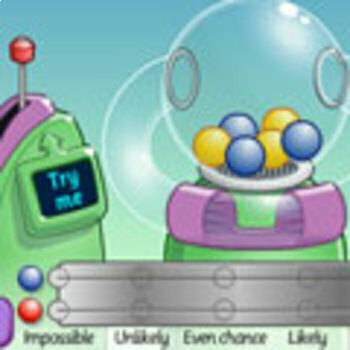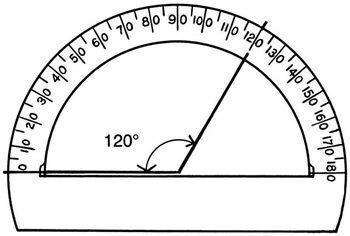EVERYDAY MATH Resource BUNDLE - YEARLONG PRACTICE In Every Topic You Teach!
- Zip
Products in this Bundle (12)
showing 1-5 of 12 products
Description
If you are tired of looking for ways to motivate students to achieve in mathematics - look no more! This year-long resource provides practice-practice-practice in fun ways. Research shows that students need extensive practice to gain essential mathematical skills and concepts. However, motivating students to engage in this practice long-term can be challenging.
With a click of a button, access interactive games, videos, and PowerPoints that provide practical mathematical strategies to accommodate diverse learning styles.
This product bundles websites designed to align with concepts taught in Units 1 - 12 of Everyday Math curricula for 5th grade. However, it is fully adaptable for other publishers and grade levels with similar skills.
The twelve chapters in this bundle offer essential practice to solidify the understanding and proficiency in the following subjects:
- Unit 1 - Number Theory
- Unit 2 - Estimation and computation
- Unit 3 - Geometry
- Unit 4 - Division
- Unit 5 - Fractions, Decimals, Percents
- Unit 6 - Addition and Subtraction of Fractions
- Unit 7 - Exponents and Negative Numbers
- Unit 8 - Fractions and Ratios
- Unit 9 - Coordinates, Area, Volume, and Capacity
- Unit 10: Algebra Concepts and Skills
- Unit 11 - Volume
- Unit 12 - Probability, Ratios, and Rates
HOW CAN IT BE USED
This versatile product is perfect for whole-class instruction on Smartboard and individual student practice.The included videos and PowerPoint presentations provide clear demonstrations and education on critical concepts. In addition, the available games and activities offer an interactive and personalized approach, complete with instant feedback and tailored pacing to each student's needs.
PURPOSE OF THE EVERYDAY MATH RESOURCE
- It provides easy classroom access to practice activities that meet students' multiple intelligences in your classroom.
- It provides daily practice for students to reinforce skills taught in the classroom for each lesson in fun and engaging ways.
- It provides opportunities for family interaction and connection.
BENEFITS OF THE EVERYDAY MATH RESOURCE
Practicing math is crucial for students to master the necessary skills. However, motivating them to continue can be challenging. Student engagement in educational gaming can positively impact math achievement.
- Using computer games in educational settings positively affects academic achievement, attitudes toward learning, and self-concept compared to traditional instruction.
- Educational gaming offers immediate feedback, increases active learner participation,
- It reinforces knowledge and influences attitudinal changes.
- Playing high-quality, interactive games influences mathematics achievement and self-efficacy in math.
- Educational gaming favors the development of complex thinking skills and problem-solving, planning, and self-regulated learning.
- The impact on learning is astronomical because of the high degree of student interaction and engagement with content and subject matter that constantly reinforces knowledge and challenges thinking.
Recommended Grade Levels: 4 – 6
Thank you for your interest and for purchasing products in my store. Your support is immensely appreciated, and as a valued customer, your feedback is always welcome. Feel free to connect with me in the following ways.
PLEASE STAY CONNECTED.
- Feel free to email me at fostbr@comcast.net
Follow me at Best Practice Learning Resources by Brenda Foster on:
WEBSITE| FACEBOOK | INSTAGRAM | PINTEREST
Join my Monthly Newsletter Blog, Best Practice Learning Resources by Brenda Foster
- Receive free teaching ideas and resources, new product announcements, giveaways, freebies, and special deals and promotions.New subscribers always receive freebies.
Click ★HERE★ to follow my store.
Copyright © Brenda Foster (Best Practice Learning Resources)
- LICENSING TERMS: This purchase includes a license for one teacher only for personal use in their classroom. Rights are non-transferable and cannot be passed from one teacher to another. Part of this resource will be shared with colleagues or used by an entire grade level, school, or district without purchasing the proper licenses.
- COPYRIGHT TERMS: This resource may not be uploaded to the internet in any form, including classroom/personal websites or network drives, unless the site is password-protected and can only be accessed by students.
Sincerely,
Brenda Foster (National Board Middle Childhood Generalist)




